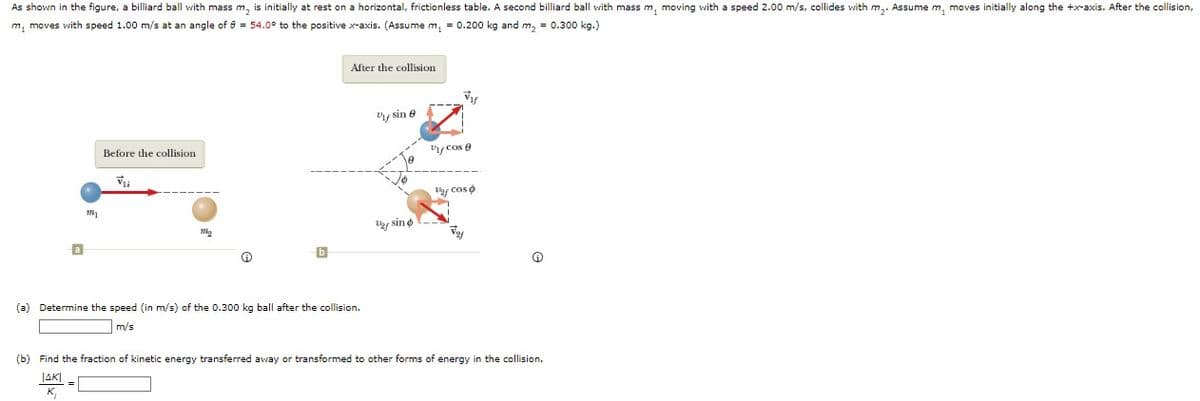As shown in the figure, a billiard ball with mass m, is initially at rest on a horizontal, frictionless table. A second billiard ball with mass m, moving with a speed 2.00 m/s, collides with m,. Assume m, moves initially along the +x-axis. After the collision, m, moves vith speed 1.00 m/s at an angle of 8 = 54.0° to the positive x-axis. (Assume m, = 0.200 kg and m, = 0.300 kg.) After the collision y sin e Before the collision Ey cos e y coso y sin o al (a) Determine the speed (in m/s) of the 0.300 kg ball after the collision. m/s (b) Find the fraction of kinetic energy transferred away or transformed to other forms of energy in the collision. JAK|
As shown in the figure, a billiard ball with mass m, is initially at rest on a horizontal, frictionless table. A second billiard ball with mass m, moving with a speed 2.00 m/s, collides with m,. Assume m, moves initially along the +x-axis. After the collision, m, moves vith speed 1.00 m/s at an angle of 8 = 54.0° to the positive x-axis. (Assume m, = 0.200 kg and m, = 0.300 kg.) After the collision y sin e Before the collision Ey cos e y coso y sin o al (a) Determine the speed (in m/s) of the 0.300 kg ball after the collision. m/s (b) Find the fraction of kinetic energy transferred away or transformed to other forms of energy in the collision. JAK|
Principles of Physics: A Calculus-Based Text
5th Edition
ISBN:9781133104261
Author:Raymond A. Serway, John W. Jewett
Publisher:Raymond A. Serway, John W. Jewett
Chapter8: Momentum And Collisions
Section: Chapter Questions
Problem 1OQ
Related questions
Topic Video
Question

Transcribed Image Text:As shown in the figure, a billiard ball with mass m, is initially at rest on a horizontal, frictionless table. A second billiard ball with mass m, moving with a speed 2.00 m/s, collides with m,. Assume m, moves initially along the +x-axis. After the collision,
m, moves with speed 1.00 m/s at an angle of 0 = 54.0° to the positive x-axis. (Assume m, = 0.200 kg and m, = 0.300 kg.)
After the collision
y sin e
Before the collision
Py cos e
Va cos o
y sin o
(a) Determine the speed (in m/s) of the 0.300 kg ball after the collision.
m/s
(b) Find the fraction of kinetic energy transferred away or transformed to other forms of energy in the collision.
JAK|
Expert Solution
This question has been solved!
Explore an expertly crafted, step-by-step solution for a thorough understanding of key concepts.
Step by step
Solved in 3 steps with 3 images

Knowledge Booster
Learn more about
Need a deep-dive on the concept behind this application? Look no further. Learn more about this topic, physics and related others by exploring similar questions and additional content below.Recommended textbooks for you

Principles of Physics: A Calculus-Based Text
Physics
ISBN:
9781133104261
Author:
Raymond A. Serway, John W. Jewett
Publisher:
Cengage Learning

Physics for Scientists and Engineers with Modern …
Physics
ISBN:
9781337553292
Author:
Raymond A. Serway, John W. Jewett
Publisher:
Cengage Learning

Physics for Scientists and Engineers: Foundations…
Physics
ISBN:
9781133939146
Author:
Katz, Debora M.
Publisher:
Cengage Learning

Principles of Physics: A Calculus-Based Text
Physics
ISBN:
9781133104261
Author:
Raymond A. Serway, John W. Jewett
Publisher:
Cengage Learning

Physics for Scientists and Engineers with Modern …
Physics
ISBN:
9781337553292
Author:
Raymond A. Serway, John W. Jewett
Publisher:
Cengage Learning

Physics for Scientists and Engineers: Foundations…
Physics
ISBN:
9781133939146
Author:
Katz, Debora M.
Publisher:
Cengage Learning

University Physics Volume 1
Physics
ISBN:
9781938168277
Author:
William Moebs, Samuel J. Ling, Jeff Sanny
Publisher:
OpenStax - Rice University

College Physics
Physics
ISBN:
9781305952300
Author:
Raymond A. Serway, Chris Vuille
Publisher:
Cengage Learning

Classical Dynamics of Particles and Systems
Physics
ISBN:
9780534408961
Author:
Stephen T. Thornton, Jerry B. Marion
Publisher:
Cengage Learning